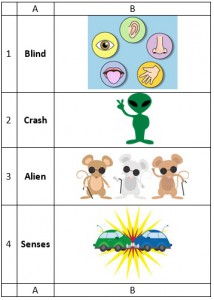Be economical with word use and
avoid excessive scrolling. Make sure that the text is easy to read by using a
clear typeface with a
legible font size (on average between 14 – 16pt) and
1.5 line spacing. Also chunk longer texts in
paragraphs. Also remember to
accompany your texts with visuals (e.g. images or video clips). Remember that if you have text for reading to
highlight the new target language in bold and/or capitals.
Tables should be
numbered so that when teaching, both you and the students know exactly which cell you are referring to. Also make sure that you
randomise the table for activities where students have to match new target language with definitions/images. This is also to ensure that students engage with the new target language rather than just no-effort reading from their part.

Remember to always
use large images & rescale to keep quality rather than the opposite & be stuck with pixelated images. Also try to
save multiple images as a single picture when creating paperless ESL activities in order to ensure that you don´t lose picture integrity.
Keep in mind when using video clips in paperless ESL activities how
appropriate the video is in terms of
level, topic & the objective of the activity. Aim for short & sweet – that is roughly
2 minutes.
When designing paperless ESL activities remember to apply the
KISS principle & don´t forget that – as with most things – there are limitations and drawbacks to any tool:
https://youtu.be/HHEYtw4IMpY

